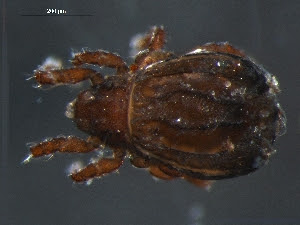Splanchnotrophids are a group of copepods endoparasitic on two orders of shell-less marine gastropods (sea slugs), the Nudibranchia and Sacoglossa. They are characterised by reduced mouthparts and appendages though they retain a distinct pair of claw-like antennae. These antennae seem to be used to hold the copepod in place in their preferred location within the body cavity of their host. Though the exact means of feeding by splanchnotrophids is not certain, their rudimentary mouthparts, combined with a rarity of observations of actual tissue damage in parasitised hosts, indicate that they probably suck nutriment from their host's haemolymph. Females and males live in association within the host, the minute (and slightly more recognisably copepod-y) males holding close to their comparatively gigantic mates. As well as their size, female splanchnotrophids differ from males in the possession of elongate, tubular dorsal outgrowths of the thorax. These are most commonly presumed to function to provide more space for the female's enlarged ovaries, though some have suggested additional functions such as maintaining position within the host, respiration or absorbing nutrients (Anton & Schrödl 2013). The female's tubular egg-sacs extend through an opening in the host's body wall to release eggs into the water column. Usually, these egg-sacs will emerge close to some outgrowth of the host's own body, such as gills or papillae, and may be coiled if relatively long; these measures presumably help protect the egg-sacs from external damage. How the released larvae find and colonise new hosts remains unknown but it is possible the antennules (the smaller second pair of antennae possessed by most crustaceans) are used to locate hosts chemically, with their reduced condition in adults the result of a halt to development once their purpose has been fulfilled.
Relatively few splanchnotrophids have been recognised to date, maybe about a dozen species divided between five genera. A few other species that had earlier been included in the family on little more grounds than that they were endoparasites of gastropods were excluded by Huys (2001)*. A sixth genus and species Chondrocarpus reticulosus is of uncertain relationships. If correctly associated with the splanchnotrophids, it is of interest in parasitising a different group of sea slugs (the pleurobranchids) and in its massive size (growing to twelve millimetres vs only a few millimetres for females of the other genera), but the only available description is inadequate for its proper characterisation. In some localities, splanchnotrophids have proven to be surprisingly abundant. A once-off survey of potential host species in Oregon found no less than 62% of individuals of one species to be infected (25 other potential host species were completely free of parasites), whereas a longer-term survey off the coast of Chile found an overall infection rate of 13% with some particular host species approaching 100% infection (Schrödl 2002). Host specificity seems to vary within the family: a study by Anton et al. (2018) found that species of the genus Ismaila tended to restrict themselves to a single host species, whereas species of Splanchnotrophus are more catholic and undiscriminating. Nevertheless, a lack of correlation between relationships of splanchnotrophid species and those of their host species suggests that, even in the more discriminating Ismaila, host changes may not have been uncommon.
*As a concise indication of just how sloppy some of the earlier work on 'splanchnotrophids' had been, one misattributed species was re-identified by Huys (2001) as having been based on the detached head of a pelagic amphipod.
The broader relationships of splanchnotrophids within copepods also remain poorly understood. A phylogenetic study by Anton & Schrödl (2013) suggested that Splanchnotrophidae may form a clade with another genus of copepods endoparasitic in gastropods, Briarella, with this clade being in turn derived from ectoparasitic ancestors. However, by the authors' own admission, this study was heavily biased in both taxon and character coverage to the Splanchnotrophidae, and may have been affected by insufficient scrutiny of non-splanchnotrophid taxa. Though derivation of the endoparasitic splanchnotrophids from ectoparasitic ancestors has a definite intuitive appeal, further study is required before we can feel confident about it.
REFERENCES
Anton, R. F., D. Schories, N. G. Wilson, M. Wolf, M. Abad & M. Schrödl. 2018. Host specificity versus plasticity: testing the morphology-based taxonomy of the endoparasitic copepod family Splanchnotrophidae with COI barcoding. Journal of the Marine Biological Association of the United Kingdom 98 (2): 231–243.
Anton, R. F., & M. Schrödl. 2013. The gastropod-crustacean connection: towards the phylogeny and evolution of the parasitic copepod family Splanchnotrophidae. Zoological Journal of the Linnean Society 167: 501–530.
Huys, R. 2001. Splanchnotropid systematics: a case of polyphyly and taxonomic myopia. Journal of Crustacean Biology 21 (1): 106–156.
Schrödl, M. 2002. Heavy infestation by endoparasitic copepod crustaceans (Poecilostomatoida: Splanchnotrophidae) in Chilean opisthobranch gastropods, with aspects of splanchnotrophid evolution. Organisms, Diversity & Evolution 2: 19–26.

























